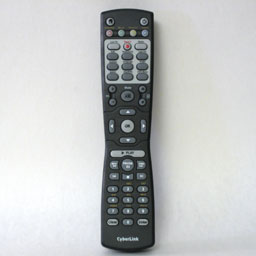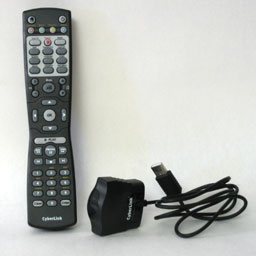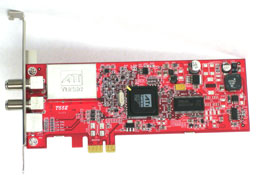HTPC - TV Tuner Reviews
by Jarred Walton on December 7, 2005 12:05 AM EST- Posted in
- Smartphones
- Mobile
PowerColor Theatre 550 Pro PCIe
The last card that we're looking at is quite a bit different from the other two. It's one of the first truly interesting PCI Express X1 cards for home users. (LAN and SATA cards might interest higher end buyers, but most people don't need to worry much about that.) Given the number of boards that are only shipping with two or three PCI slots, plus one to three PCIe X1 slots, it's nice to finally be able to put the PCIe slots to use. Now, if only someone would get around to releasing a PCIe sound card... but I digress. PowerColor is the first to market with a PCIe TV Tuner, based on the ATI Theater 550 (or "Theatre 550" if you prefer the PowerColor/British spelling, though we'll stick with Theater).
The PowerColor card is obviously inferior to the other cards in a few ways. No HDTV support is going to disappoint many people, and no QAM decoding also limits its versatility. As we've mentioned already, though, there's a big difference between doing something, and doing it well. If the analog support on the Theater 550 is clearly superior to that of the other cards, the lack of other features may not matter. We looked at analog TV Tuners several months ago, and in that roundup, the ATI Theater 550 came out on top. With the main difference being PCIe vs. PCI, hopefully we won't see any change in quality.
Something else to consider is that there are no PCIe HDTV tuners at present. With most recent motherboards only including two or three PCI slots, you could put an HDTV tuner in one of those slots and place an analog tuner in an X1 slot. Assuming that you have an add-in sound card, you may not have enough PCI slots to fully accommodate your HTPC needs. The maximum number of supported tuners under Windows MCE is four: two HD and two analog. Most people probably don't go that extreme (and good luck getting a clean signal if you split a coaxial input more than four ways), but it's still something to consider.
Besides the card, you once again get a remote, a USB infrared receiver, and a software bundle. There's also an input cable that allows the use of S-VIDEO or Composite sources, and you get an FM antenna and input. (Radio reception is as bad as OTA TV reception, so I didn't bother trying it. I'm not much of a radio listener anyway.) The remote is definitely more attractive than the Fusion remote, but the MyHD remote is still the smallest of the three. As with the Fusion remote, be careful of the power button, as you can accidentally shut down the PC (or put it in suspend mode) rather than just turning off the software interface. To shut down PowerCinema, you actually press the "Home" button twice. (Duh - as if that's not totally clear....) The placement of the power button on the remote makes it easier to hit, unfortunately, and on several occasions I forgot to use the Home/Power button. Some people may like the feature, but we generally just leave HTPCs running and found it to be more annoying than anything.
The software bundle of the PowerColor card is quite extensive. You get a large selection of CyberLink products with the package, and while several are "Lite" versions, they'll still suffice for most people: PowerDVD, PowerProducer DVD, PowerDirector SE+, Power2Go, MediaShow SE, and PowerCinema. Will you actually need most of that software? Probably not, but it doesn't hurt to have it. Also note that the remote is technically from CyberLink and is made to work with the above software, so if you were to purchase a different Theater 550 card, you would get some other remote. The remote is MCE compliant, though, so you can use it with either interface.
The last card that we're looking at is quite a bit different from the other two. It's one of the first truly interesting PCI Express X1 cards for home users. (LAN and SATA cards might interest higher end buyers, but most people don't need to worry much about that.) Given the number of boards that are only shipping with two or three PCI slots, plus one to three PCIe X1 slots, it's nice to finally be able to put the PCIe slots to use. Now, if only someone would get around to releasing a PCIe sound card... but I digress. PowerColor is the first to market with a PCIe TV Tuner, based on the ATI Theater 550 (or "Theatre 550" if you prefer the PowerColor/British spelling, though we'll stick with Theater).
The PowerColor card is obviously inferior to the other cards in a few ways. No HDTV support is going to disappoint many people, and no QAM decoding also limits its versatility. As we've mentioned already, though, there's a big difference between doing something, and doing it well. If the analog support on the Theater 550 is clearly superior to that of the other cards, the lack of other features may not matter. We looked at analog TV Tuners several months ago, and in that roundup, the ATI Theater 550 came out on top. With the main difference being PCIe vs. PCI, hopefully we won't see any change in quality.
Something else to consider is that there are no PCIe HDTV tuners at present. With most recent motherboards only including two or three PCI slots, you could put an HDTV tuner in one of those slots and place an analog tuner in an X1 slot. Assuming that you have an add-in sound card, you may not have enough PCI slots to fully accommodate your HTPC needs. The maximum number of supported tuners under Windows MCE is four: two HD and two analog. Most people probably don't go that extreme (and good luck getting a clean signal if you split a coaxial input more than four ways), but it's still something to consider.
 |
 |
| Click to enlarge. | |
Besides the card, you once again get a remote, a USB infrared receiver, and a software bundle. There's also an input cable that allows the use of S-VIDEO or Composite sources, and you get an FM antenna and input. (Radio reception is as bad as OTA TV reception, so I didn't bother trying it. I'm not much of a radio listener anyway.) The remote is definitely more attractive than the Fusion remote, but the MyHD remote is still the smallest of the three. As with the Fusion remote, be careful of the power button, as you can accidentally shut down the PC (or put it in suspend mode) rather than just turning off the software interface. To shut down PowerCinema, you actually press the "Home" button twice. (Duh - as if that's not totally clear....) The placement of the power button on the remote makes it easier to hit, unfortunately, and on several occasions I forgot to use the Home/Power button. Some people may like the feature, but we generally just leave HTPCs running and found it to be more annoying than anything.
The software bundle of the PowerColor card is quite extensive. You get a large selection of CyberLink products with the package, and while several are "Lite" versions, they'll still suffice for most people: PowerDVD, PowerProducer DVD, PowerDirector SE+, Power2Go, MediaShow SE, and PowerCinema. Will you actually need most of that software? Probably not, but it doesn't hurt to have it. Also note that the remote is technically from CyberLink and is made to work with the above software, so if you were to purchase a different Theater 550 card, you would get some other remote. The remote is MCE compliant, though, so you can use it with either interface.











77 Comments
View All Comments
8steve8 - Wednesday, December 7, 2005 - link
bottom line:if i want to watch/record hdtv channels like HBO and/or discover via a PC...
im out of luck?
those channels are not ota... are provided through a cable provider....
i can do this once cable card finally comes around?
JarredWalton - Wednesday, December 7, 2005 - link
HBO and most other movie channels are encrypted. Funny enough, some of the on demand channels seem to be picked up. For instance channels 101-1, 101-2, 102-1, 102-2, and several subchannels on the physical channels 93 and 94 all showed what amounts to random content. Movies, cartoons, and yes, even porn. If you tuned in to one of the channels, sometimes you would see it going to fast-forward mode, like the person watching the content was skipping ahead.Cable card is supposed to allow you to view encrypted content on TVs as well as computers without a set-top box. Until I see it in actual use, though, I'm not exactly sure how it's going to work. I would assume it will just store an encrypted TP file, and the cable card will contain the decryption logic.
nullpointerus - Wednesday, December 7, 2005 - link
http://en.wikipedia.org/wiki/Cablecard">http://en.wikipedia.org/wiki/CablecardI've been waiting for decent HTPC CableCard products for ~2 years now. They'll probably come out very late in 2006, achieve their intended interoperability sometime between the second and third generation of products, and become practically flawless around the same time that they become obsolete. That's just a guess, mind you...
Tujan - Wednesday, December 7, 2005 - link
It was intriging because nobody has really compared the use of DIY HTPCs. With what limited parts are available.I wouldn't use a non-multicore processor for something dealing with HDPCs. Just the shear amount of graphics and screen space,the relative newcomer to its display of screen space,. The notorious 'switching between apps,and those running in the background,- much less using the PCI bus to do so.
What I did miss out of this story,was a shot of a connected MYHD130 to its screen display. Kind of lost me there. With the connect ups to utilizing a screen,and the computers video card. See Im reading imagining toggling between user interface,remote,and what this means to the rigging of separate devices outside the computer itself.Caveat Emptor for/from them along side. And you mentioned that ATI was 'out-of-the-picture , for HDTV unless the components where hooked up. So to share that ATI graphics cards are not useful for the MYHD130.
Would certainly make a wish list to the MYHD130 to put it onto the PCI-e lane.Get it off the PCI bus.
As for those encrypted channels.Are you sure they would stay that way ? Think you could pick out your PPV (Pay-Per-view) channel from that list ? [ ]
You mentioned your Monitor,that they have in common Overscan.I simply have the question included to involve just how a HTPC will correctly recognize a monitor (consider a 32 to 40" LCD TV) ,when most this involves the PNP feature Ive known for doing so.? [ ]
ATI cards aren't any good with the DTV if using the DVI for/from them for the HD screens ? Think 32" to 42" LCD TVs here.[ ]
- glad your doing the experimenting here.Good article.
JarredWalton - Wednesday, December 7, 2005 - link
LCD TVs shouldn't have a problem with overscan. Any rear projection displays will have overscan, and I believe all DLP have overscan as well. There are some good DLP displays that only have 1% overscan, though -- too bad they're really expensive.If you want a picture of what the MyHD looks like when connected, let me see about uploading one and I'll provide a link. This is with the DVI daughter card:
http://images.anandtech.com/reviews/multimedia/tvt...">DVI Passthru Image
http://images.anandtech.com/reviews/multimedia/tvt...">VGA Passthru Image
Hopefully that's clear - there's a lot of cable clutter, so I labeled the pertinent connections.
Tujan - Wednesday, December 7, 2005 - link
Thanks for reply. Even though I know a lot,Im still a novice. Know a lot of the acronymns,but dealing with things marketed off the top just keeps me on to them for a limited span.The picture there,the top card is the video card,with the lower cards being the TV tuners then.Im thinkin that somehow your giving up a controlled connection to your display from the computer by using the MyHD130 ? Or it limits the 'out of your video card when you only would have a single hook up on the Display.[ ]
- I will go to there site to look for more.
Encryption ? [ ] Mean if you subscribe to HBO via your home cable line,HBO will not be able to be seen if utilizing the HTPC with the QAM/HD TV cards ?
Certainly the situation would be averted for the configuration of the cable to Display(cable box to default display) - since (T,F) the Display has an encryption chip within it to do so,(1),or (2) Encryption is handled via the cable box. With everything else dealing with something of the HDCP,HDMI type scenarios.... The encryption mechanism has got to work somewhere in the final render at the Display. Certainly the Cable Company isn't selling me the Display.....
Of course this is a whole nother anchalotta.
I pretty much just look for the configuration compatibility in the input,output for the hookups.And if the software will work/..how difficult to navigate them.
Thinking everythings hunky dory after a large investment ...Again thanks for reply.
JarredWalton - Wednesday, December 7, 2005 - link
Decryption of the encrypted channels is handled by the cable box. The cable card standard will allow other devices to do that decryption -- basically, the key/algorithm will be stored on the cable card. Of course, that means you need to have a TV and or computer that has a cable card slot. Hopefully they'll make a USB adapter.mariush - Wednesday, December 7, 2005 - link
I'm a bit dissapointed that you have used Divx to test the analog recording. XViD would have probably been much faster, at least that's how it is on my computer.Also, I would probably either use XViD set to record with quantizer 1 (max quality) which takes about 6-10 MB/s at 768x576 25fps or I would use a lossless encoder such as HuffYUV (~12 MB/s at 768x576 25fps)
JarredWalton - Wednesday, December 7, 2005 - link
The DivX codec is officially supported by the MyHD software. Xvid was far slower, and that holds in general, unless there is a special setting to get it to encode faster. All the real-time encoding has to be done through a VFW codec, and I couldn't find a fast codec to handle that. The DivX codec is also the only codec that allows you to resize the video content, at least as far as I could tell. Otherwise you end up with an incorrect aspect ratio, as seen on the top left picture on page 15.If you download the videos, you might feel that the DivX codec results in a loss of quality, even on the X2 system. That video sample is actually very close to what you see when watching live analog content with the MyHD card. At best, it's decent analog video. Just about any analog-only TV tuner will produce equal or better output.
Back to the codecs, if you really want to get a decent compression, while not losing a lot of quality, I would recommend using a second PC or re-encoding the videos while your computer is sitting idle. You could do the same thing with the TP files, re-encoding them using the Xvid codec with a data rate of around 1 GB per hour and the target, resolution of 720 x 480 -- or perhaps go for 2/3 GB per hour and target a 1280x1024 resolution.
One of the benefits of the DivX codec is that quite a few consumer-electronics devices now support it as well. I'm not aware of any DVD players that can handle Xvid.
xtknight - Wednesday, December 7, 2005 - link
Sorry for the double post, but by the way, the program AVI.NET can encode xvid and divx for standalone players. That's the whole purpose of it: to use only the features standalone players support. I recommend you try it out.